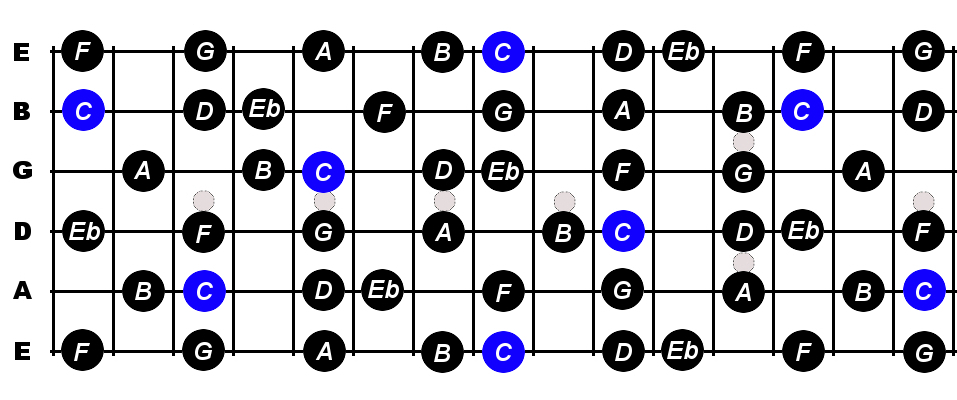

- #NATURAL HARMONIC AND MELODIC MINOR SCALES GUITAR HOW TO#
- #NATURAL HARMONIC AND MELODIC MINOR SCALES GUITAR FULL#
How Can You Practise the Minor Harmonic Scale? You can also learn more about the chromatic scale. This is a little complicated to remember but if you remember that it’s just the minor natural scale with the seventh raised by a semitone. To better understand, here are two ways to remember it: Here’s the structure of the minor natural scale: The main difference is that there’s a semitone difference on the seventh. By starting from the A minor scale, the G will be altered: A B C D E F G# A. The minor harmonic scale is built on the minor natural scale. There are three semitones between the tonic and the third. In this case, you’ll want to learn a scale as useful as the minor natural scale.
#NATURAL HARMONIC AND MELODIC MINOR SCALES GUITAR HOW TO#
You’ll inevitably come across a style of music that you’ll want to play and want to learn how to improvise and compose. The reason we don’t say D# because you can’t have two Ds in the same scale, that’s why you say Eb (they’re the same notes, after all). Try to do the same starting from F (answers at the end of the article). To improve your guitar playing, here’s a way to remember the C natural minor scale: Start by learning the structure of the natural minor scale. Then try playing the scale by starting from any note on the neck, then across one or two strings, then on three, working your way up until you can play it across all six strings. It’s a great way to practise using your plectrum and your fingering with your left hand (the reverse if you’re left-handed). It’ll be simpler! You'll need to study a bit to get the hang of scales. Come back to minor scales after you’ve studied the guitar for a while. If you’re a beginner, focus on the fingering from the pentatonic scale, learning the rhythm, the basic chords, and barre chords. How to Practise the Natural Minor Scale on the Guitar You should need to remember that certain notes will become either sharps or flats and vice-versa. For example, the A minor scale is the following: A, B, C, D, E, F, G, A. These are exactly the same notes as in the C major scale. The second of these two methods is the intervals in the scale in terms of frets. If you remember the structure, you can play the scale in any key. There are two ways to remember the scale:
#NATURAL HARMONIC AND MELODIC MINOR SCALES GUITAR FULL#
Each note is no more than a full tone apart (be it a tone or a semitone). There are 6 notes between the first and last notes. Just like the major scale, the natural minor scale is made up of seven notes. Work on your guitar playing whenever you can. This is the first minor scale you should learn. The natural minor scale is also called the Aeolian mode. They’re very useful for improvising, composing, and also harmonising and making chords.

There are only a few differences between each of them. There are three minor scales each with their own structure: the natural, the harmonic, and the melodic, which we’re all going to look at in more detail. This is true of all minor relative scales. When the third is minor, it’s almost always a minor scale. The recognise a minor scale, you need to check that there are three semitones between the tonic and the third. How Can You Recognise a Relative Minor Scale? The difference is in the order of the notes that are played. The other notes that are altered are the sixth and sevenths. Each major scale has a relative minor scale, the scale that it shares all its notes with. In fact, there are several minor modes that produce minor scales.Īll minor scales have an altered third. To be fair, there’s no such thing as the minor scale. In the major scale, there are two tones in the interval whereas there are three semitones in the minor scale. The minor third gives the minor scale a more melancholic feel whereas a major key feels more optimistic. The sixth degree of C is A. To better understand a minor scale, you need to focus on the interval between the tonic (the first note) and the third. The minor relative scale is built from the 6th degree of the major scale. On a guitar, a tone is usually separated by two frets and a semitone is separated by one fret. To play a scale, you have to apply a mode. The interval is the distance between two notes: usually a tone or a semitone. A mode is defined by the intervals separating the fundamental and the different degrees. Make sure you're one with your instrument. The minor scale, after the major scale, is arguably the second most important guitar scale to learn.


 0 kommentar(er)
0 kommentar(er)
